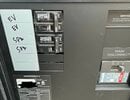I have an existing 4kw micro-inverter system, but just put in to Tesla for a 4.8kw system plus one Powerwall (one is all I really need for either load-shifting or backup).
I know the general parameters in this forum are that one needs at least two Powerwalls, even three, for whole-house backup, but most of those threads are regarding homes with air-conditioning and the compressor startup loads. But I don't have central air-conditioning. Is the two Powerwall rule an absolute, or does it depend on the actual house panel and breakers, or even more specifically on actual loads?
I have a fairly new 200A panel (one of those California ones with the meter socket in half of the panel. The panel is largely full, but there are only three 240V breakers:
-40A for air-conditioning compressor. However, my air compressor from the 60's has not worked since I remodeled, so this circuit was re-purposed for my 1st gen Tesla HPWC. Tesla's whole-home backup page says TWC are compatible with whole-home backup, and I could swap the HPWC for a TWC if the communications are needed to shed the EV charging load. Even if I do get a new compressor, I'm planning to get an inverter compressor in the 2-2.5 ton range, so it shouldn't have a heavy startup load.
-30A for electric dryer. However, we have a gas dryer, so this circuit is largely unused.
-40A for electric oven. I do know the oven draws about 5 kw continuous when pre-heating, and then intermittently to maintain . So certainly the oven alone would hit the max output of one Powerwall - but I also know I would not plan to do any baking during a grid outage.
-There's also the 240V breaker for the existing solar - but that's generation, not load.
Aside from the 240V loads, there are 28 20A breakers for 120V. But in practice, 1-2 kw is really the max ever being used at one time. Certainly if all the circuits were running at max, the load would exceed one Powerwall - but then again it would exceed 8 Powerwalls. So there's a huge difference between actual expected loads and theoretical max loads.
Is it possible to get a load evaluation to determine if I could have whole-house backup with just one Powerwall? Or with my type of integrated panel, would they have to move all of the backup loads off the main panel anyways, so it really doesn't matter much between whole-house and partial backup?
I know the general parameters in this forum are that one needs at least two Powerwalls, even three, for whole-house backup, but most of those threads are regarding homes with air-conditioning and the compressor startup loads. But I don't have central air-conditioning. Is the two Powerwall rule an absolute, or does it depend on the actual house panel and breakers, or even more specifically on actual loads?
I have a fairly new 200A panel (one of those California ones with the meter socket in half of the panel. The panel is largely full, but there are only three 240V breakers:
-40A for air-conditioning compressor. However, my air compressor from the 60's has not worked since I remodeled, so this circuit was re-purposed for my 1st gen Tesla HPWC. Tesla's whole-home backup page says TWC are compatible with whole-home backup, and I could swap the HPWC for a TWC if the communications are needed to shed the EV charging load. Even if I do get a new compressor, I'm planning to get an inverter compressor in the 2-2.5 ton range, so it shouldn't have a heavy startup load.
-30A for electric dryer. However, we have a gas dryer, so this circuit is largely unused.
-40A for electric oven. I do know the oven draws about 5 kw continuous when pre-heating, and then intermittently to maintain . So certainly the oven alone would hit the max output of one Powerwall - but I also know I would not plan to do any baking during a grid outage.
-There's also the 240V breaker for the existing solar - but that's generation, not load.
Aside from the 240V loads, there are 28 20A breakers for 120V. But in practice, 1-2 kw is really the max ever being used at one time. Certainly if all the circuits were running at max, the load would exceed one Powerwall - but then again it would exceed 8 Powerwalls. So there's a huge difference between actual expected loads and theoretical max loads.
Is it possible to get a load evaluation to determine if I could have whole-house backup with just one Powerwall? Or with my type of integrated panel, would they have to move all of the backup loads off the main panel anyways, so it really doesn't matter much between whole-house and partial backup?



